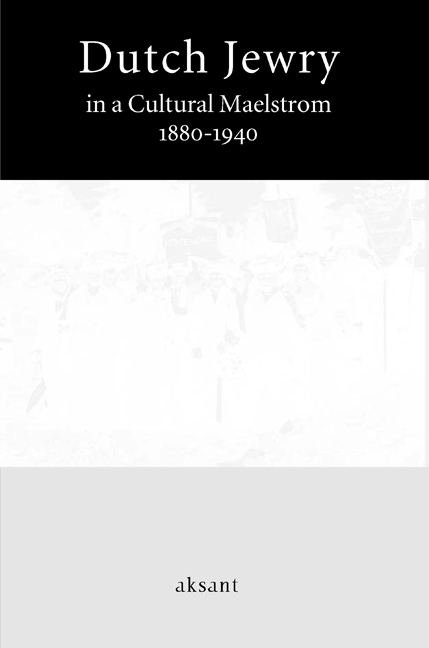Book contents
- Frontmatter
- Contents
- Foreword
- The New “Mosaik”: Jews and European Culture, 1750-1940
- The Politics of Jewish Historiography
- “The First Shall be the Last”: The Rise and Development of Modern Jewish Historiography in the Netherlands Until 1940
- Epigones and Identity: Jewish Scholarship in the Netherlands, 1850-1940
- Judaism on Display: The Origins of Amsterdam's Jewish Historical Museum
- De Vrijdagavond as a Mirror of Dutch Jewry in the Interbellum, 1924-1932
- “Holland is a Country which Provokes Serious Reflection…”: Images of Dutch Jewry in the German Jewish Press
- Spinozism and Dutch Jewry between 1880 and 1940
- Spinoza's Popularity in Perspective: A Dutch-German Comparison
- Mozes Salomon Polak: Jewish “Lerner” and Propagator of Freemasonry, Spiritualism, and Theosophy
- Jewish Women, Philanthropy, and Modernization: The Changing Roles of Jewish Women in Modern Europe, 1850-1939
- Roosje Vos, Sani Prijes, Alida de Jong, and the others: Jewish Women Workers and the Labor Movement as a Vehicle on the Road to Modernity
- Stemming the Current: Dutch Jewish Women and the First Feminist Movement
- Dutch Jewish Women: Integration and Modernity
- Index of Names of Persons
- Index of Subjects
Spinoza's Popularity in Perspective: A Dutch-German Comparison
Published online by Cambridge University Press: 26 January 2021
- Frontmatter
- Contents
- Foreword
- The New “Mosaik”: Jews and European Culture, 1750-1940
- The Politics of Jewish Historiography
- “The First Shall be the Last”: The Rise and Development of Modern Jewish Historiography in the Netherlands Until 1940
- Epigones and Identity: Jewish Scholarship in the Netherlands, 1850-1940
- Judaism on Display: The Origins of Amsterdam's Jewish Historical Museum
- De Vrijdagavond as a Mirror of Dutch Jewry in the Interbellum, 1924-1932
- “Holland is a Country which Provokes Serious Reflection…”: Images of Dutch Jewry in the German Jewish Press
- Spinozism and Dutch Jewry between 1880 and 1940
- Spinoza's Popularity in Perspective: A Dutch-German Comparison
- Mozes Salomon Polak: Jewish “Lerner” and Propagator of Freemasonry, Spiritualism, and Theosophy
- Jewish Women, Philanthropy, and Modernization: The Changing Roles of Jewish Women in Modern Europe, 1850-1939
- Roosje Vos, Sani Prijes, Alida de Jong, and the others: Jewish Women Workers and the Labor Movement as a Vehicle on the Road to Modernity
- Stemming the Current: Dutch Jewish Women and the First Feminist Movement
- Dutch Jewish Women: Integration and Modernity
- Index of Names of Persons
- Index of Subjects
Summary
The German Jewish philosopher Constantin Brunner wrote in 1909 of something that deeply disturbed him: he had heard that bricks had been tossed on the lap and feet of the statue of Spinoza in the Hague, and that these bricks were left there by local Jews. “Could one imagine that the blind hatred against Spinoza still persists in the lower echelons of the Jewish population of Holland?”, he asked his readers rhetorically.
Brunner's surprise was a result of the contrast of this Dutch-Jewish attitude with the almost self-evident popularity Spinoza had enjoyed among Jews in Germany in the course of the nineteenth century. By the time Brunner wrote these words, German Jews had become significant participants in Spinoza scholarship. The first German to attempt a genuine rehabilitation of Spinoza happened to be a Jew, namely Moses Mendelssohn. Later, in the mid-nineteenth century, a Jew was the first to translate Spinoza's complete works into German, and Jacob Freudenthal, author of a classic biography of Spinoza, was a Jew. These are but a few of the many German Jews who published books and articles on Spinoza. At the same time, in spite of his acceptance in Germany, Spinoza never became that important to Dutch Jewry. The bricks on his statue are but one incident. One could also point to the unveiling of this monument, which was such a non-Jewish event that it was celebrated on the eve of Yom Kippur, the festive dinner taking place at the very moment that Dutch Jews were beginning their fast, singing “Kol Nidrei”. In this paper I will investigate why Spinoza attracted relatively so many German Jews. In order to do so, I will discuss a theme common to the Spinoza reception of Moses Mendelssohn, Heinrich Heine, and Max Grunwald. I will subsequently return to Brunner's question and try to explain why such a positive Jewish reception of Spinoza was never realized in the Netherlands.
GERMAN JEWISH SPINOZISM
It is impossible here to accurately portray the diversity of German Jewish publications about Spinoza. There are many reasons German Jews were attracted to Spinoza. Some were inspired by his break with Judaism; living in an era in which emancipation, integration, and assimilation were pressing issues, Spinoza could serve as an example for them. Particularly inspiring was the fact that his estrangement from Judaism did not lead to his conversion to Christianity.
- Type
- Chapter
- Information
- Dutch Jewry in a Cultural Maelstrom, 1880-19401880-1940, pp. 121 - 130Publisher: Amsterdam University PressPrint publication year: 2008

